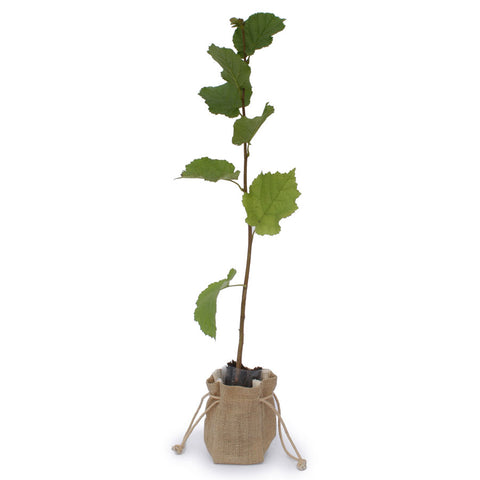Hazel Tree Facts and Information
- Latin Name: Corylus avellana
- Native words: Old Irish (coll), Scots Gaelic (calltuinn), Old English (haesel), Welsh (colleen), Eastern Celtic ()
- Ogham sign: C
- Height when mature: 4–6m (13–20ft)
- Height after 10 years: 3–4m

Hazel Botanical Description
Hazel is one of the smallest native tree species in the UK, typically growing more like a shrub. Mature trees reach around 20 feet tall.
The bark is smooth and dark brown on young trees, becoming cracked with age. Hazel leaves are large, round, and pointed, double-toothed (each tooth has a smaller tooth), and grow on short stalks. They have a hairy texture and appear wrinkled when mature.
In February, male catkins resembling lamb’s tails shed yellow pollen. Female catkins, which appear further back on the branches, are small and bud-like with a red-tipped style. These develop into the pale green hazelnuts.
Hazel Natural History and Ancient Wisdom
Many ancient woods, now dominated by oak, ash, or wych elm, were once hazel coppices. Hazel is particularly well-suited to coppicing — a historic woodland management technique where trees are periodically cut to the base to regrow multiple rods.
These rods were historically used for wattle and daub in building, woven fencing, fish traps, thatching poles, hedge-laying stakes, and charcoal production.
At Tudeley Woods in Kent, before WWI, 900 men were employed coppicing hazel and shipping wood to London for heating. With coppicing in decline, hazel is being replaced by sycamore and other species that shade it out. Hazel requires sunlight to produce pollen effectively.
Hazelnuts were a key food source for early Britons and remain widely used today — often in chocolate products.
Hazel still grows widely in hedgerows, but must be allowed to grow taller to fruit. The leaves and catkins make identification easy even in low hedgerows.
In Irish and Welsh mythology, hazel trees are revered. The "hazelnuts of wisdom" were said to grow at sacred wells and riverheads in Ireland. Hazel rods were used for witchcraft, water divination, and burial rituals. The salmon of knowledge — a mythological creature also associated with rowan berries — fed on hazelnuts and was ultimately caught by Fionn mac Cumhaill (son of the hazel).

Hazel Place Names in the UK
- Hazel Hurst (throughout England) – “hazel wood”
- Haslemere (Surrey) – “lake where hazels grew”
- Hazelwood (Derbyshire)
- Hazleton (Gloucestershire)
- Haswell (Durham) – “well where hazels grew”
Hazel Wildlife Rating
High. Hazelnuts are an excellent food source for red squirrels, although grey squirrels often strip trees completely, limiting germination.
Nightingales thrive in coppiced hazel woodlands, particularly in southern England. The decline in coppicing has contributed to their population decline.
Managed hazel coppices also host a greater diversity of insects than unmanaged stands, supporting moths like Buff Tip and Large Emerald, and attracting warblers and other birds.
Hazel Good Points / Bad Points
- Compact size makes hazel suitable for small gardens or use in hedging.
- Showy male catkins brighten late winter landscapes.
- Excellent for wildlife-friendly gardens and woodland planting.



































































